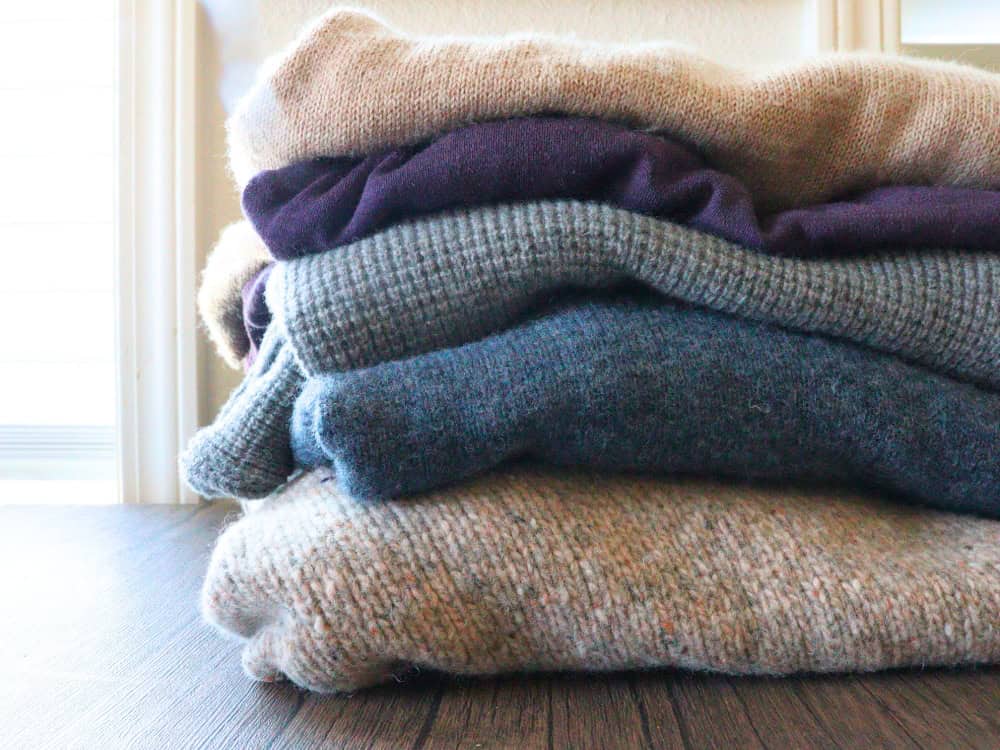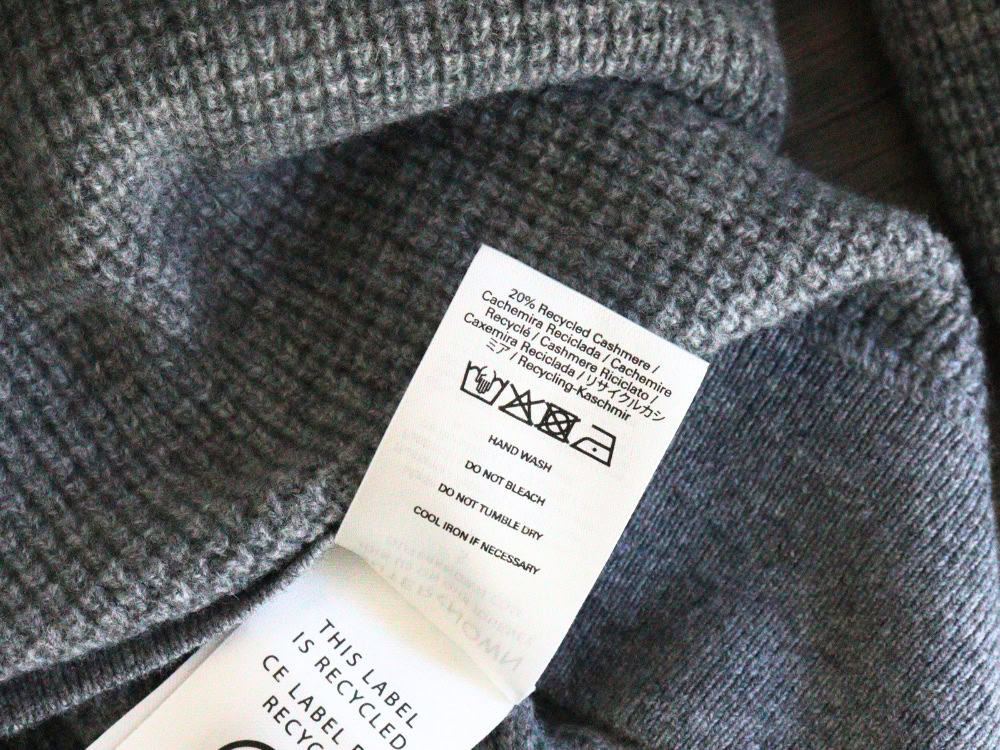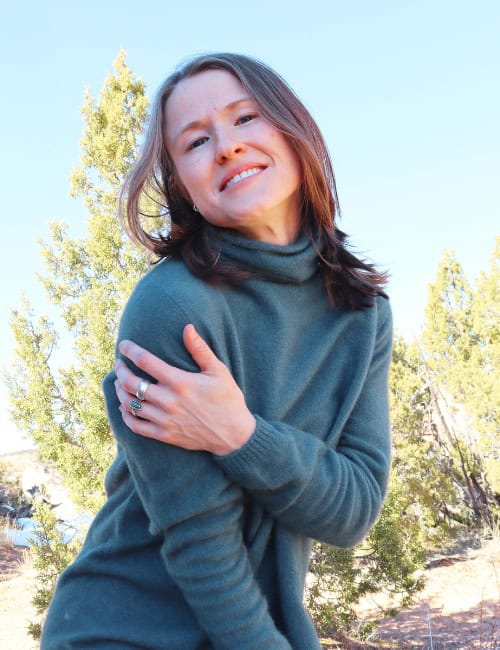
Ethical Cashmere: Where Does Cashmere Come From & Is it Sustainable?
Anyone familiar with the plethora of animal rights abuses in the fashion industry may be excused for being a little sceptical of the term ‘ethical cashmere‘.
Claims of sustainability and ethical manufacturing are big money in today’s economy. To be blunt, green sells—like really sells—which makes it difficult to sort tell a conscious, sustainable cashmere sweater from one that comes with all kinds of animal, labor, and land abuse.
Like ethical wool in general, ethically-sourced cashmere certainly isn’t the norm, but does that mean it’s all-around impossible?
Let’s unravel the fabric to see if it’s really as soft on animals and the environment as cashmere itself—or if it’s all a bunch of hogwash (or rather, goat-wash).
The Full List Of Sustainable Cashmere Considerations
- Where does cashmere come from?
- Is cashmere ethical?
- Is cashmere sustainable?
- Cashmere vs other wools
- Ethical cashmere brands
1. Where Does Cashmere Come From?

Cashmere, also known as kashmir, gets its name from the region in which it was initially produced—Kashmir, a territory located between Pakistan and India. References of kashmir fabric generally date back to the third century BC, with some indications that it was around even earlier than that.
Like any wool, cashmere fabric is made from the hair of an animal—specifically the undercoat of a cashmere goat.
These goats are commonly found in Central Asia and the Gobi Desert region. They’ve been traditionally raised in Northern Asian countries like Nepal and Tibet but now the largest producers are China, Mongolia, Afghanistan, and Iran.
Cashmere goats are known for their remarkably soft wool that won’t leave wearers feeling itchy like some other types of wool.
Technically a microfiber (like pashmina and yak wool), cashmere is classified by three market grades: Grade C (up to 30 microns per fiber) is the lowest quality, followed by Grade B (16-19 microns), and finally the super fine Grade A (a mere 13 microns). For reference, the average strand of human hair is 75 microns, with the finest hair being as small as 17 microns.
It’s not as insulative as other types of wool, but it is one of the softest and most luxurious-feeling fabrics —which explains those eye popping price tags. Even the lowest cashmere grades are more valuable than most other wool.
2. Is Cashmere ethical?

Because it comes from an animal, we already know it’s not vegan, but is cashmere cruelty-free?
While goats aren’t killed for cashmere products, it’s not uncommon for them to suffer from the process. From that standpoint, it’s valid to dismiss ethical cashmere yarn as a possibility at all.
Cashmere Ethical Issues: Animal Welfare
In the Kashmir region, winter temperatures are low and in some places reach -40°F. Combined with their rougher, weather-repellant outer coats, the luxuriously soft and downy wool on cashmere goats allows them to survive several months during these conditions—and also makes them a lucrative resource.
The goats naturally shed this wool in the spring. During this time, producers can comb this wool out in a way that doesn’t hurt the goats or deprive them of their needed winter insulation. The act of combing versus shearing is a less aggressive method of harvesting the hair that won’t lead to cuts (accidental, careless, or otherwise) in the goats’ skin.
While some suppliers practice this cruelty-free cashmere harvesting method, they’re in the minority since it’s far more time consuming (and thus less lucrative) than shearing.
Many are known to shear the goats too early, too, causing them to freeze to death.
Even when shearing is done at the right time, many times the goats are required to be chained down. This places a lot of stress on the goats, during which their sudden, anxious movements can lead to injuries and cuts even for the most conscious shearers.
This has led to organizations like PETA fighting back against cashmere production by exposing its ugliest sides, as well as an ever-growing list of brands who have banned the fabric.
Cashmere Ethical Issues: Herder Welfare
Throughout history, cashmere has been a prized fabric for nobles and royalty.
However, as the overall wealth of the world has increased, the “democratizing” of cashmere has led to a skyrocketing demand. In 2020, the global cashmere clothing market was valued at $2.64 billion, with a projected 6% increase by 2030. Once exclusive to luxury and boutique shops in the past, cashmere can now be found in sweaters sold at budget retailers like Costco.
Where demand goes up, so do the demands of the people who herd or process the fabric. To keep up, farmers often have to increase their herd sizes only to be met with dwindling prices.
Many workers along the cashmere supply chain are being subjected to unsafe work conditions and unfair pay that doesn’t cover a basic living.
Unfortunately, you won’t see the official Fair Trade certification on cashmere of any kind, which makes discerning good cashmere from bad even more difficult.
As grim as that sounds, it’s not all black and white. Done properly, cashmere can provide much-needed livelihood opportunities for people, especially in Mongolia, where other industry opportunities are few and far between.
In the past decade, the number of Mongolian herdsmen has tripled to more than 450,000 people. Differing from global urbanization trends, the economy in Mongolia has done the opposite and encouraged people to return to rural areas and lifestyles. For some of these people, they have greatly benefited from the cashmere industry.
While most ethical cashmere brands look ot Mongolia these days, that’s not to say cashmere can’t be consciously sourced from elsewhere. Be sure to look for those that pay direct to supplier prices (meaning no middle man to take a percentage of the profits).
3. Is Cashmere Sustainable?

From a sustainability standpoint, the greatest of all cashmere benefits is its biodegradability. Provided it hasn’t been blended with any synthetics, cashmere is 100% home compostable.
It also often forgoes toxic processing chemicals for fear of ruining the fine fiber.
But in terms of durability, cashmere leaves a lot ot be desired. As one of the finer fabrics with short fibers, it’s prone to pilling and can become damaged eqasily, and thus should be worn carefully, washed gently by hand, and folded, rather than hung.
Unfortunately, even if well-cared for and worn for years, that doesn’t negate all the harm that comes from raising cashmere animals themselves.
The Un-Goat-ly Impact Of Cashmere Goats
Goats have notoriously sharp hooves and are not the most delicate of eaters. They use their hooves to break down into the topsoil, then rip up grass and plants—roots and all, meaning the grass won’t grow back.
Coupled with the fact that goats eat 10% of their body weight every day, land simply doesn’t have enough time to regenerate itself after it’s served as an all-you-can-eat buffet for a full herd of goats.
To see this devastation, look at China, the world’s largest producer of cashmere. When the demand for cashmere meant a doubling of the number of goats in 1993 to 44 million by 2009, it took such a significant toll on grazing lands that dust storms seen in cities like Beijing are a direct result of goat over-herding and its associated desertification.
Farther north in Mongolia, the situation is even direr. Since the fall of communism in 1990 (which capped the county’s livestock at 20 million), Mongolia has become the world’s second highest cashmere producer, with over 70 million goats today.
The region now commonly experiences a unique phenomenon known as a dzud, a severe winter storm that follows a summer drought that killed over 9 million animals in 2010.
Ironically, as millions of goats are commonly lost by the terribly cold temperatures, it causes herders to raise more goats that eat more food, leading to malnourishment and lower quality fur from unhealthy animals. Again, herders increase their livestock numbers to compensate, perpetuating this vicious cycle.
This cashmere crisis is just as alarming as it sounds, and the numbers speak for themselves. Mongolia is on a fast track to expedited climate change, with average temperatures having risen 3.85°F since the 1940s. For reference, that’s twice that of Earth’s average temperature increase in the same timeframe.
For these reasons, there is no perfectly sustainable cashmere (unless it’s recycled), but there are some certifications to help us choose better options:
- The Good Cashmere Standard: Developed by the Aid by Trade Foundation (AbTF), The Good Cashmere Standard was launched in early-2020 to help improve the welfare of the goats, the communities that raise them, and the environment in which they live.
- The Sustainable Fibre Alliance (SFA): SFA is a multi-stakeholder initiative dedicated to the long-term sustainability of the cashmere sector. The Standard is used by producers who meet SFA’s criteria about environmental impact, animal welfare, and herder livelihoods.
4. Cashmere Vs Other Wools

While producers have experimented with a range of synthetic alternatives for cashmere, they haven’t been successful. That said, however, there are other natural fibers that might be a suitable cashmere alternative.
Merino Wool
Remember how we mentioned that it requires the hair of four goats to produce one sweater?
Alternatively, just one merino sheep can produce enough for eight to 10 sweaters.
Merino is relatively similar to cashmere (just not as soft, really), but is considered to be a much more sustainable option. Merino sheep tend to be raised in areas where the topography doesn’t make it suitable for much else.
Over-grazing also isn’t as much of a problem and certifications like those by ZQ and the Responsible Wool Standard (RWS) go even further to ensure sustainable practices and humane animal treatment.
Alpaca Wool
Raising alpacas in the Peruvian mountains don’t come with the same environmental concerns experienced in the cashmere industry.
Alpacas only eat 1% to 2% of body weight per day (compared to a goat’s 10%) meaning they don’t overgraze, are a well-established part of the natural ecosystem, and provide livelihood opportunities for indigenous farmers.
They’re also a culturally and economically respected animal, so you can feel a little more comfortable. Though always check sourcing practices, because there are no guarantees.
Yak Wool
Yak wool has been called “the new cashmere” by numerous entities. That’s not just because it’s actually softer than a lot of Grade B and C cashmere (between 18-20 microns), but because it’s far more sustainable and could prove to be the future of Mongolia’s cashmere industry.
Mongolia’s indigenous Khangai yak is a gentle grazer, with a shorter tongue that does not pull out the grass by its roots. Combined with the fact that they are usually raised by traditional nomadic herding families that continually move with their animals, they prevent overgrazing in one particular area.
Plus, their fur yields itself to hand-combed harvesting far better than shearing.
5. Ethical Cashmere Brands

Whether you’re looking for something to treat yourself, or want to purchase a cashmere scarf as a gift, there are some traceable, sustainable cashmere brands that can’t be bleat:
- Naadam‘s range is made with what they call “the only cruelty-free cashmere.” They hand-comb their goats, pay higher direct-to-supplier prices to herders, provide livestock insurance and veterinary care funds for herders, and give back through a partnership with the Gobi Revival Fund. More importantly, they set herding limits and winter their goats in an area the size of Manhattan to minimize overgrazing.
- Outerknown and Reformation both have shunned virgin cashmere (or in Ref’s case, are almost there) in favor of recycled alternatives. In fact, Reformation specifically calls out their reasons for phasing out the fiber, stating that while virgin cashmere makes up less than 1% of their total fiber use, it accounts for nearly 40% of their footprint.
- Untouched World uses mostly opossum fiber (an extremely invasive rodent that poses huge threat to their new Zealand home ecosystem), but they also use some ZQ merino wool and cashmere in blends. Their stringent animal welfare policies ensure all animals are treated ethically.
Despite these proof-positive brands, most still have a long way to go.
Discerning those that are making a genuine effort from those that aren’t is even more difficult given the lack of transparency.
The burden unfortunately falls on us as responsible consumers to comb out the legitimate threads. Just remember “ethical cashmere” is a big selling point, so be sure that the brand can back up their claims and don’t fall victim to greenwashing.
That said, if you’re looking for the GOAT of cashmere sweaters, second hand or recycled cashmere is the way to go.
Did you know we Have a Newsletter?
We cover the latest in sustainable living, fashion, zero waste, beauty, travel, finance and more…
Pin these:






I am interested in the concept of cruelty free cashmere but very sceptical as it is difficult to ensure. I would rather not buy it because of this risk. Only if the company knows and is committed to cruelty free sourcing and this is so hard to do. I will not buy cashmere.
VERY USEFUL INFORMATION. DID NOT KNOW UNTIL YESTERDAY AFTER SEEING PETITION ON FACEBOOK HOW CRUELY POOR GOATS TREATED. PREFER CASHMERE AS AM 83, V.DISABLED AND IT’S BETTER FOR MY VERY DRY SKIN. SHALL NOW CHECK OUT THE BRANDS SUGGESTED.
Thank you very much for all the information. I was looking for cashmere products but wasn’t sure if they were cruelty free and now is super clear and I am definitely not buying them anymore
Ethical cashmere is vip important. Besides Naadam could you name a few other brands.
Thanks that would be helpful.
Best
Bernie
Hi Bernie, it certainly is hard to find brands who use responsible cashmere. We mention quite a few in this article on work clothing and this article on loungewear – they include Another Tomorrow (recycled), Filippa-K, Eileen Fisher (mix of recycled and virgin cashmere) and Vitamin A (mostly recycled).
Thank you for all the information. We will not be buying cashmere for our store at this time.